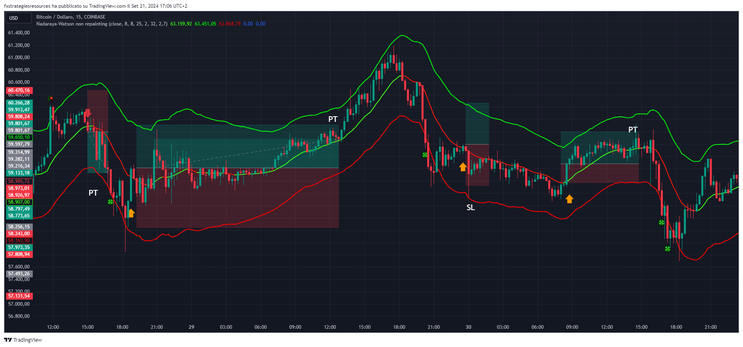144# Nadaraya-Watson Reversal Strategy Non Repainting TradingView
Submit by Janus Trader 2024
Overview:
This strategy aims to catch market reversals at the upper and lower bands of the Nadaraya-Watson Non-Repainting indicator. It uses overbought and oversold conditions for entry signals and relies on candle closes above or below the median line to confirm the trades. The stop-loss is placed at the previous swing high or low, and a risk-reward ratio of 1:0.8 to 1:1 is used to define the profit target.
Time Frame 15 min or higher.
Currency pairs:any.
Indicator:
-
Nadaraya-Watson Non-Repainting: This indicator uses a Rational Quadratic Kernel for trend estimation and defines an upper and lower band using the ATR (Average True Range). The upper and lower bands represent overbought and oversold conditions, respectively.
-
ATR Period: 32
-
ATR Multiplier: 2.7
-
Strategy Steps:
1. Identify Overbought and Oversold Signals:
-
A buy signal (🍀 symbol) is generated when the price crosses below the lower band.
-
A sell signal (🥀 symbol) is generated when the price crosses above the upper band.
2. Entry Criteria:
-
Long Position (Buy):
-
Wait for the buy signal to appear below the lower band.
-
Enter the trade only if a subsequent candle closes above the median line (middle band) or when the midlle line is green.
-
-
Short Position (Sell):
-
Wait for the sell signal to appear above the upper band.
-
Enter the trade only if a subsequent candle closes below the median line, or when the median line is red.
-
The approach of entering when the candle closes above or below is more aggressive but still has a good profitability > 58%.
3. Stop-Loss Placement:
-
Place the stop-loss at the previous swing high for a short trade and at the previous swing low for a long trade.
-
This allows for natural market fluctuations without prematurely stopping out the trade.
4. Take-Profit Criteria:
-
The profit target should be set according to a risk-reward ratio of 1:0.8 to 1:1. In other words:
-
For every 1 unit of risk, aim for a profit of 1.8 to 2 units.
-
If the stop-loss is set at a 10-pip distance from the entry point, the take-profit should be placed at 18 to 20 pips.
-
5. Exit Criteria:
-
Close the position when the price reaches the defined take-profit level, or if the stop-loss is hit.
-
You can also exit if a reversal signal is confirmed (e.g., if you are in a long position, and a new sell signal appears with a candle closing below the median line).
Example:
-
Long Setup: The price crosses below the lower band, and a 🍀 signal appears. You wait for a candle to close above the median line or at green line, then enter a long trade. The stop-loss is set at the previous swing low, and the profit target is set at a distance equal to 1.8–2 times the risk.
-
Short Setup: The price crosses above the upper band, and a 🥀 signal appears. You wait for a candle to close below the median line or at red line, then enter a short trade. The stop-loss is set at the previous swing high, and the profit target is 1.8–2 times the risk.
Risk Management:
-
Risk 1-2% of capital per trade.
-
Always adhere to the 1:0.8 to 1:1 risk-reward ratio for a balanced risk-return profile.
Advantages:
-
Non-Repainting Indicator: The Nadaraya-Watson regression is non-repainting, meaning signals do not change after the fact, improving the reliability of the strategy.
-
Clear Entry/Exit: The use of median line confirmation reduces false signals and provides clear conditions for entry and exit.
Disadvantages:
-
Range-Bound Markets: The strategy may produce false signals in low volatility, range-bound markets, as price can fluctuate around the bands without a clear trend.
This reversal strategy is designed to capitalize on extreme price movements by relying on the Nadaraya-Watson indicator’s bands and confirmation from price action.
- 130# Trend Forecast - Forex Strategies - Forex Resources -
- Breakout Forex Strategies - Forex Strategies - Forex Resources ...
- 28# 4H Strategy: RSX and Murrey Math - Forex Strategies - Forex
- 71# 3 Duck's - Forex Strategies - Forex Resources - Forex
- 44# Murrey Math - Forex Strategies - Forex Resources - Forex ...
- 41# Range Breakout - Forex Strategies - Forex Resources - Forex
- 119# Trend Forex - Forex Strategies - Forex Resources - Forex ...
- 94# Forex Soloist Method - Forex Strategies - Forex Resources ...
- 52# N Bars Strategy - Forex Strategies - Forex Resources - Forex
- 222# Forex Trend System - Forex Strategies - Forex Resources ...
- 63# 1 min Scalping - Forex Strategies - Forex Resources - Forex
- 11# Cornflower - Forex Strategies - Forex Resources - Forex ...
- 34# Hoover Method - Forex Strategies - Forex Resources - Forex
- 163# I2G Free Analyzer - Forex Strategies - Forex Resources ...
- 136# 1 min Scalping with Pivot Points (IX) - Forex Strategies -
- 28# Simple Scalper - Forex Strategies - Forex Resources - Forex









Write a comment